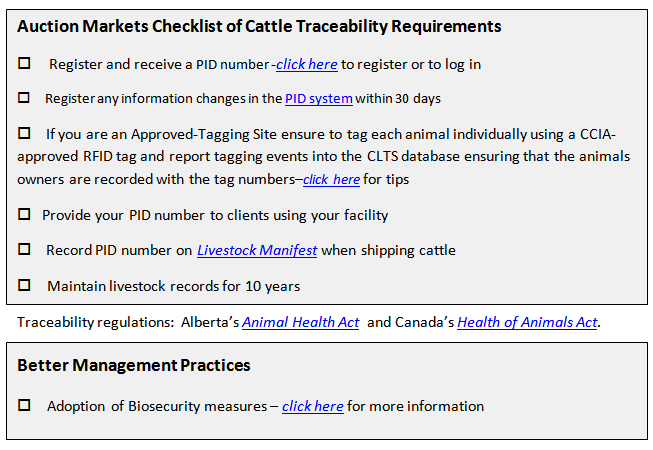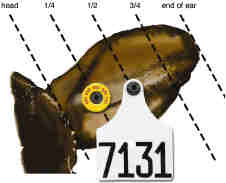| | Premises Identification | Animal Identification | Traceability Home
.
| Traceability is a crucial component of an effective animal health and food safety system that enables precise and rapid emergency response to protect livestock, producers and consumers. Determining where livestock are, where they have been and what other livestock they have come into contact with allows for efficient emergency planning and response. Traceability in Alberta relies on the three fundamental pillars of premises identification, animal identification and animal movement. |
Click here to print this checklist

Premises Identification
Premises Identification (PID), one of the three traceability pillars, is a way of linking livestock and poultry to land locations. The information collected through the Alberta Agriculture and Forestry (AF) Premises Identification System allows industry and government to locate animals more quickly and accurately to confine a disease outbreak or emergency such as a flood or fire. Animal owners can be notified if an emergency might affect their animals and operation but this can only be accomplished if land locations are registered in the Premises Identification System.
Under Alberta’s Premises Identification Regulation, if you operate a commingling site (e.g. stable, community pasture, fair ground, etc.), you are required to obtain a PID Account, register all your commingling sites and provide the PID Number(s) to the users of your site(s). You must apply for a PID Account within 30 days of assuming ownership or operation of a commingling site.
If you own a livestock animal or poultry, and that animal is kept at a premises other than a commingling site (e.g. stable), you need to apply for a PID Account and obtain at least one PID Number associated to where the animal(s) are located. You must apply for a PID Account within 30 days of assuming ownership of an animal. If you own an animal that is only kept at locations controlled by someone else (e.g. stable) and that animal will never be kept at a premises under your care and control (e.g. farm or acreage), you are not required to register for a PID Account. However, you will need to obtain the PID Number from the operator of the site.
To find out the species of animals included under the regulation, click here.
How to apply and update your account
| To apply for a PID Account or to access/update it online: | Click here |
| To apply for a PID Account or to update it by paper application:
(PID paper application forms are also available at AF Field Offices located throughout Alberta.) | Click here |
Registering your premises is one of the best ways to safeguard your animals and it’s free. It is important that you keep your information up to date and you must report account changes within 30 days. For example, this would include changes in account contact information, maximum capacity of the premises and contact information for emergencies. If the PID System does not contain accurate and up-to-date information, the emergency response might be delayed.
Animal owners will need to have a PID Number to:
- Buy medication for your animals at retail outlets (this requirement took effect on July 1, 2014 as part of amendments to the Animal Health Act)
- Complete movement documents such as manifest and permits, if required, when transporting your animals.
- Sell livestock at auction markets
- Apply for many government sponsored agriculture grants and programs
For additional information on the PID Program:
Important note: Information must be kept up to date so that you can be contacted quickly in the event of an emergency.
Animal Identification for Cattle
As an auction market and an Approved-Tagging Site, you play a key role in the traceability system for livestock in Alberta and Canada. Accurate and current information supporting cattle movement and identification is key to a robust traceability system. Please remember to report tagging events and associate newly tagged cattle with the owners’ Canadian Cattle Identification Agency (CCIA) accounts within 24 hours.
Under the Traceability Cattle Identification regulation, owners must tag cattle born after January 1, 2009 with a CCIA- approved radio frequency identification (RFID) cattle tag and report the birth date into the Canadian Livestock Tracking System (CLTS) or CLTS - Lite (a quicker version of the CLTS without the pictures) before the animal leaves the farm of origin or within 10 months, whichever comes first. All other cattle must be tagged with a CCIA-approved RFID cattle tag before leaving the farm of origin.
 | If an animal loses an RFID tag, the tag must be replaced and should be cross-referenced with the original tag number in the CLTS. Cross-referencing the data will mean that all of the events uploaded by the producer against the tag and the history of the animal will be maintained. Producers can log onto their accounts in the CLTS to cross-reference tags or contact the CCIA office at 1-877-909-BEEF. |
The use of CCIA-approved RFID tags allows for a rapid and reliable method of tracking livestock from farm of origin to slaughter without slowing the speed of commerce. One of the benefits of cattle tagging is having the individual animal’s information at your finger-tips for livestock management decisions.
CCIA has been working with producers and industry to establish quality assurance procedures and processes around the use of RFID technology and the supporting equipment.
If you have a tag-related complaint, please complete this form and submit to the CCIA or call 1-877-909-BEEF (2333).
| As an important member of the livestock industry, you play a key role in the traceability system for livestock in Alberta and Canada. Accurate and current information supporting premises identification, animal identification and movement is crucial to a robust traceability system. Please take care to ensure that information associated with your animals is accurate and that information supporting traceability is documented. |
Traceability Home |
|